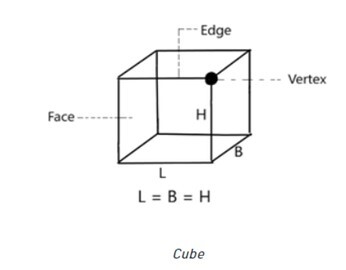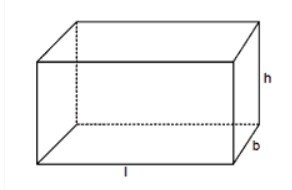
 Data Structure
Data Structure Networking
Networking RDBMS
RDBMS Operating System
Operating System Java
Java MS Excel
MS Excel iOS
iOS HTML
HTML CSS
CSS Android
Android Python
Python C Programming
C Programming C++
C++ C#
C# MongoDB
MongoDB MySQL
MySQL Javascript
Javascript PHP
PHP
- Selected Reading
- UPSC IAS Exams Notes
- Developer's Best Practices
- Questions and Answers
- Effective Resume Writing
- HR Interview Questions
- Computer Glossary
- Who is Who
Difference between Cube and Cuboid
Introduction
The difference between a cube and a cuboid is that a cube has six identically sized square faces while a cuboid has rectangular faces . Only the cuboid and the cube are two such solids that have certain shared qualities, such as each having six faces, eight vertices, and twelve edges. There are numerous shapes in geometry, such as cylinders, spheres, and cones, that have distinct properties. Additionally, all inside angles are 90 degrees.
In this tutorial, we will discuss the difference between Cube and a Cuboid.
Polyhedrons
Polyhedrons are 3D shapes with straight edges, flat faces, straight edges, and sharp vertices (corners). The word "polyhedron" comes from the Greek word "poly" which means "many" and "polyhedron" means "area or surface". Therefore, when many planes are joined together, they form a polyhedron. These shapes are named according to their faces, which are usually polygons.
Polyhedra are divided into two types based on their edges. They are regular polyhedrons and irregular polyhedrons.
Regular Polyhedron
A regular polyhedron is also known as a platonic solid if its faces are congruent and regular polygons. All of the polyhedral angles in a regular polyhedron are equal. Five regular polyhedrons are present.
Irregular Polyhedron
An irregular polyhedron is one that has irregular polygonal faces that are not congruent to one another and with unequal polyhedral angles.
Euler's formula can be expressed as
$$\mathrm{F\:+\:V\:-\:E\:=\:2}$$
Where F denotes the number of faces, V denotes the number of vertices, and E denotes the number of edges.
Cubes
A cube is a three-dimensional figure made up of identically sized square-shaped faces. A cube's angles all intersect at 900. The six equal faces of a cube are all square in shape. It contains 12 identical edges and 8 vertices.
The cube shown below has the dimensions l for length, b for breadth, and h for height. The cube's edges are represented by its length, breadth, and height. The point where the three edges come together is referred to as a vertex.

Cuboids
A three-dimensional figure with rectangular faces is known as a cuboid. A cuboid is a figure with a box shape. Additionally, a cuboid has 8 vertices and 12 edges. The cuboid's faces and edges are not all equal. On the other hand, the cuboid's opposing faces are equal.
The cuboid is depicted in the figure below. where l equals length, b equals width, and h equals height, $\mathrm{l\neq\:b\neq\:h}$.

Difference between Cube and Cuboid
| Cube | Cuboid |
|---|---|
| Height, width, and length are all identical in size. the sides and edges are equal. | Height, width, and distance measurements are not equal. i.e., the sides and edges are not equal. |
| All six faces of a cube are squares. | All six faces of a cuboid are rectangles. |
| A cube has a surface area measurement of one and has a total of 12 diagonals. | A cuboid has 12 total diagonals, of which 3 are distinct in the measure. |
| Examples include the Rubik's cube, dice, and ice cube. | Examples of cuboids are lunch boxes and bricks. |
| A cube is a square's three- dimensional counterpart. | A rectangle in three dimensions is called a cuboid. |
| The four internal diagonals of a cube should all be the same size. | There are four internal diagonals in a cuboid, and two pairs of internal angles have distinct measurements. |
| Total Surface Area $\mathrm{=\:6a^{2}}$ | Total Surface Area $\mathrm{=\:2(lb\:+\:bh\:+\:hl)}$ |
| Curved Surface Area $\mathrm{=\:4a^{2}}$ | Curved Surface Area $\mathrm{=\:2h\:(l\:+\:b)}$ |
| $\mathrm{Volume\:=\:a^{3}}$ | $\mathrm{Volume\:=\:l\times\:b\times\:h}$ |
Solved Examples
1) Find the volume of a cube whose length of the sides is 2.
Answer We know that the formula for the volume of a cube is $\mathrm{a^{3}}$
$$\mathrm{Volume\:of\:cube\:=\:a^{3}}$$
$$\mathrm{=\:2^{3}\:=\:8}$$
2) Find the volume of a cuboid whose length, breadth, and height are 2, 3, and 4.
Answer We know that the formula for the volume of a cuboid is $\mathrm{l\times\:b\times\:h}$
$$\mathrm{Volume\:of\:cube\:=\:l\times\:b\times\:h}$$
$$\mathrm{=\:2\times\:3\times\:4}$$
$$\mathrm{=\:24}$$
3) What is the surface area of a cube if the length of the sides of the cube is 4.
Answer It is given that the length of the sides of the cube is 4 and we know that the formula for the surface area of the cube is $\mathrm{6a^{2}}$
$$\mathrm{Surface\:area\:of\:the\:cube\:is\:=\:6a^{2}}$$
$$\mathrm{=\:6.4^{2}\:=\:96}$$
4) How many vertices (corners) does a cube have?
Answer Eight.
5) Can a polyhedron have 11 faces, 22 vertices, and 33 edges?
Answer This can be verified easily by Euler's formula.
$$\mathrm{F\:+\:V\:-\:E\:=\:2}$$
Given, faces(F) = 11
Vertices (V) = 22
Edges(E) = 33
Now put these in the above formula,
$$\mathrm{LHS\:=\:F\:+\:V\:-\:E}$$
$$\mathrm{=\:11\:+\:22\:-\:33\:=\:0}$$
$$\mathrm{RHS\:=\:2}$$
$\mathrm{\Longrightarrow}$ LHS does not equal RHS
Hence, There is no polyhedron for the given conditions.
6) A solid has 14 faces and 12 vertices. How many edges does the solid have?
Answer Polyhedral Formula/Euler's Formula $\mathrm{f\:-\:V\:-\:E\:=\:2}$
Therefore, $\mathrm{14\:+\:12\:-\:E\:=\:2}$
or,$\mathrm{\:\:\:\:\:\:\:\:\:\:\:\:\:\:\:\:\:\:\:\:\:26\:-\:E\:=\:2}$
or,$\mathrm{\:\:\:\:\:\:\:\:\:\:\:\:\:\:\:\:\:\:\:\:\:\:\:\:\:\:\:\:\:\:\:\:\:E\:=\:26\:-\:2\:=\:24}$
or,$\mathrm{\:\:\:\:\:\:\:\:\:\:\:\:\:\:\:\:\:\:\:\:\:\:\:\:\:\:\:\:\:\:\:\:\:E\:=\:24}$
Therefore, the solid has 24 edges
Conclusion
The main distinction between a cube and a cuboid is that a cube has six identically sized square faces while a cuboid has rectangular faces. Although the structure of a cube and a cuboid are similar, they differ in a few ways based on the length of their edges, diagonals, and faces.
FAQs
1. What Differs a Cube from a Cuboid, Specifically?
Although the structure of a cube and a cuboid is fairly similar, each form differs in terms of its edge, length, diagonals, and faces. A cube has six identically sized square faces, while a cuboid has rectangular faces. A cube is square in shape, whereas a cuboid is rectangular.
2. Can Cuboids also be referred to as Cubes?
Since a cube is a 3D square-shaped object with equal length, breadth, and height on all sides, it can be referred to as an exceptional cuboid. The cube is made up of six faces, twelve edges, and eight vertices, each of which connects three faces and three edges. A cube's opposing edges are equal and parallel to one another. A cuboid, on the other hand, is a 3D rectangular shape with unequal sides.
3. The Cuboid is what shape?
A cuboid is a 3D figure with a box-like shape and three opposing pairs of rectangular faces. Six faces make up the cuboid, and each pair of opposite faces is equal to the other.
4. Can we call a cube a square?
No, a square cannot be referred to be a cube because its sizes are different. A cube is a 3D figure with length, breadth, and height, whereas a square is a 2D figure with length and width. A cube has 12 sides and 8 vertices, compared to a square's four sides and four vertices.

